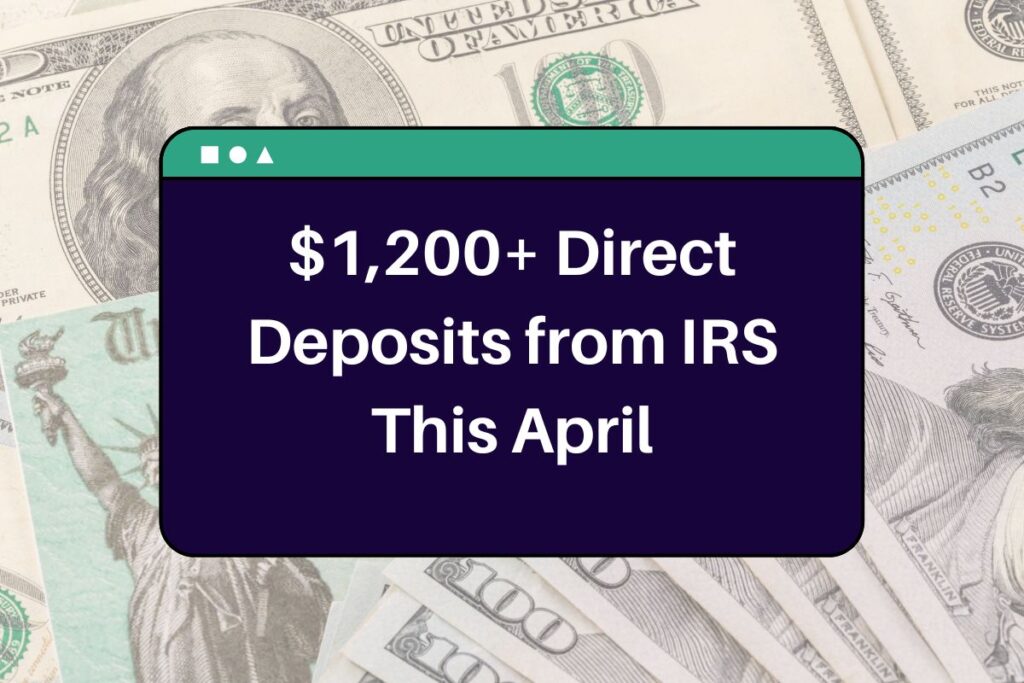This April, the IRS is distributing more than $1,200 in direct payments as part of the Recovery Rebate Credit. This additional stimulus funding, up to $1,400 per person, may be available to you if you did not get the full amount of your third Economic Impact Payment (EIP). However, the deadline April 15, 2025 is drawing near.
A refundable tax credit called the Recovery Rebate Credit was created to assist those who were not able to receive all or part of the third wave of stimulus payments in 2021. Under APR, the third EIP was first made available in March 2021 and then via other rounds more money was shared.
$1,200+ Direct Deposits from IRS This April
The epidemic of COVID-19 affected everyone. Both people and the economy were severely impacted. A number of tax relief initiatives were launched in an attempt to provide some respite to those impacted. Each of them might be accessible according to certain criteria. Recently, it was found that qualified people can still get stimulus payments from the epidemic. These include about $1 billion because of the 1.1 million persons who have not yet submitted their claims. To get this you must fulfill IRS $1,200+ Direct Deposits 2025 Eligibility, tax returns must be submitted before April 15, 2025. The three-year turnaround period for claiming a tax credit is mandated under the statutory refund window.
The money will be returned to the US Treasury and anything submitted after that time will no longer be eligible. For taxpayers who were not able to get stimulus money during the epidemic, the Recovery Rebate Credit offers a second opportunity. Making the effort to submit a 2021 return might result in a large income increase, especially when households deal with growing expenditures in 2025, since up to $1,400 per eligible person is available.
Are You on the List for Recovery Rebate Credit?
The government’s pandemic relief payments benefited millions of Americans. In the early stages of the COVID-19 epidemic, EIPs (Economic Impact Payments) were available to US residents but not all of them made these claims. For those who did not file their 2021 tax returns, this is applicable, overall $814 billion was distributed to families across the United States during the March 2020–March 2021 reporting period.
A lot of individuals who qualified for the EIPs were given stimulus or recovery rebate credits. Eligible taxpayers who did not get the EIPs during the COVID-19 epidemic were entitled to access this refundable credit. However, it was observed in December of last year that not all of the candidates for these advantages made use of them. In fact, around a million taxpayers. Inaccurate or partial information was submitted during the 2021 tax registration season.
Either the data field on the form was accidentally filed as $0 or it was left blank and these individuals would get notification letters along with a $1,400 payout. These reimbursements would be paid by direct bank deposit or by check mailed to the address they provided in 2023. Payments would have been received by the end of January if this had been done beforehand.

The recovery rebate credit for 2021 is still available
Some people did not submit their 2021 tax returns. Many things, including unemployment, were to blame for this. The recovery rebate credit may also be available to many of these individuals. This implies that their 2021 tax return must be submitted by the current tax deadline of April 15 at the latest. This is significant even if the person has very little or no money from a job, company, or other source. The amount of the EIP refund is shown on the person’s online account on the IRS website.
Early preparation is key to an un-stressful tax season
People should begin getting ready for the April 2021 tax return filing deadline, the IRS advised. This gives enough time for obtaining and preparing the appropriate documents. Entering all relevant data into the individual’s online IRS account is the best method to accomplish this. The taxpayer might seek important documentation from their employer or bank. Tax returns and transcripts of tax accounts can also be mailed by the IRS.
To seek a transcript of income or wages, one can fill out form 4506-T, although this process could take too long. The help provided to individuals impacted by the COVID-19 epidemic is still important even if it feels like a long time ago. I recommend such persons to take advantage of this before the offer expires.
Latest Update by IRS
According to the most recent IRS statistics, the average tax refund is larger than it was during the previous data release this month. However, the IRS notes that when more tax returns are received, the figures may vary and IRS advises taxpayers to make sure they submit their taxes.
IRS revealed that around 1 million taxpayers failed to collect their RRC on their 2021 tax return. The agency enabled the automatic payment option for those individuals who did not claim the credit. In order to streamline the procedure and guarantee that qualified individuals would not require extra paperwork, this was done.
This refund of $1200+ is available to qualified individuals, according to the IRS and main beneficiaries of this benefit are those who failed to file their 2021 tax returns. Up to April 15, 2025, the IRS is allowing qualified Americans to submit their 2021 refunds. Citizens must submit their taxes in order to be eligible for this benefit, even if they have very little income or none at all during that time.
A person who did not claim the Economic Income Payment (EIP) on their federal tax return for 2020 or 2021 may still be eligible to do so. Each taxpayer’s registered address is the mailing address for notices associated with EIP. These notifications list the allotted sums. By reviewing these notices, residents may be able to determine whether they should make a claim for the EIP from the prior year that they might have missed:
- Notice 1444 shows 1st EIP sent for the fiscal year 2020.
- Notice 1444-B shows 2nd EIP sent for fiscal year 2020.
- Notice 1444-C shows 3rd EIP sent for fiscal year 2021.
Taxpayers can visit their individual IRS accounts and look at the Economic Impact Payment Information section on the Taxpayer Record page if they need to confirm any payments they have received related to EIP.
| Official Website | Click Here |
| Homepage | OFSSBihar.in |



